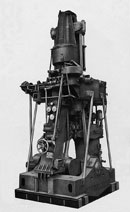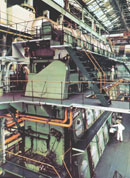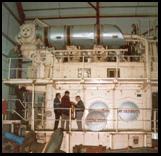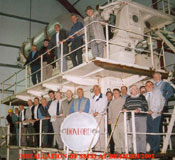 |
|||||||
| THE DOXFORD 58JS3 MARINE OIL ENGINE AND ‘The Doxford Engine Friends' Association' The Doxford 58JS3 marine oil engine is one of the most internationally significant artefacts in the Tyne and Wear Museums (TWM) collections. Doxford machinery powered several notable passenger liners, but by in large they were used in cargo vessels-general cargo ships, oil tankers, bulk carriers of grain and minerals, ships with refrigerated holds for meat and dairy produce and latterly, container ships. Some of these ships brought raw materials to Britain for industry; others carried food for the dinning table. They exported manufactured goods to worldwide markets. The Doxford engine was a powerful workhorse of world trade. William Doxfords and Sons Ltd. were well-established builders of wooden and then steel ships. The first steam engine works was opened in 1878. In 1905 they won the blue ribbon for producing the largest tonnage of any shipbuilding firm in the world. At the same time they began to investigate the potential of the gas-engine propulsion for ships, but after three years it was decided not to proceed with this idea.  1st Opposed-Piston Engine In 1912 an experimental single cylinder opposed-piston oil engine was designed and after two years was successfully demonstrated in November 1914 by Karl Otto Keller a Swiss engineer. This was put on hold till after the First World War. In 1919 a new four cylinder opposed piston oil engine was successfully developed. This was installed in the Doxford built ship ‘Yngaren' in 1921 for Swedish ship owners. Thus was established a new type of marine power unit which was developed and refined on Wearside over the next sixty years.  1st 'J' Engine 1964 The final chapter of the Doxford oil engine began with the introduction of the ‘P' and then the ‘J' type engines in the early 1960's. The last new Doxford engine design was known as the 58JS, on which design work began in the autumn 1976. The 58JS engine was developed in response to the escalating fuel costs, to provide compact direct drive machinery for smaller ships, which could then run on cheap low-grade heavy fuel oil. The piston stroke was shortened from that of the normal ‘J' type engines to enable a faster speed of 220rpm. Reliability at this higher speed was achiebved through technology derived from the important joint Doxford-Hawthorne Leslie Seahorse prototype engine of 1971-75. The only 58JS engines made were 10 three-cylinder machines, designated 58JS3 (580mm cylinder bore, ‘J' type, ‘S' short stroke, and 3 for No of cylinders.)  85JS3 At Beamish British Shipbuilders decided to cease production of the Doxford engine as the last of the 58JS3 engines left the works. Thus the preserved engine represents the ultimate development of the only and very significant British engineering success story, and it embodies the skills of many generations of expert engineers. A core provision in Tyne and Wear Museums (TWM) collecting policy is the preservation of the representative and significant examples of the region's marine engineering heritage. In view of the inclusion of a Doxford engine in the TWM collection is readily justifiable. An important factor with regard to the engine's nation and international significance is the use of components from several UK suppliers, and some from suppliers abroad. Examples are the pistons rings (made by the Standard Piston Ring Co. Ltd. Of Sheffield) the bearing shells (made by the Glacier Metal Co. Ltd of Wembley) and the exhaust turbocharger (made by brown Boveri of Baden, Switzerland)  1st DEFA Meeting 2002 Since its transfer to the Regional Museums Store (RMS) the preserved engine has excited a great deal of interest. The RMS has a public viewing gallery accessible to every visitor to Beamish during the summer season (April-October.) The engine is one of five prominent exhibits, which are interpreted by graphic panels in the viewing gallery, and they are achieving visitor numbers of around 8000 per month. The formation by TWM of ‘The Doxford Engine Friends Association' in January 2003 was a response to the many enquires received from people who wish to support efforts to look after the engine and, on a broader front, to preserve the heritage and promote the history of marine engineering on Wearside. The Association now has over one hundred members and holds well-attended quarterly meetings. Members provide specialist advice to TWM on the care and maintenance of the engine. In another promising development the Association is working closely with South Tyneside College . Under the guidance of their lecturers, and with the help from the Association members, marine engineering students carry out maintenance work on the preserved engine as part of their training. The Regional Museums Store has secured the future of the engine in the long term, and it has provided greatly enhanced opportunities for access to it.
|
|||||||